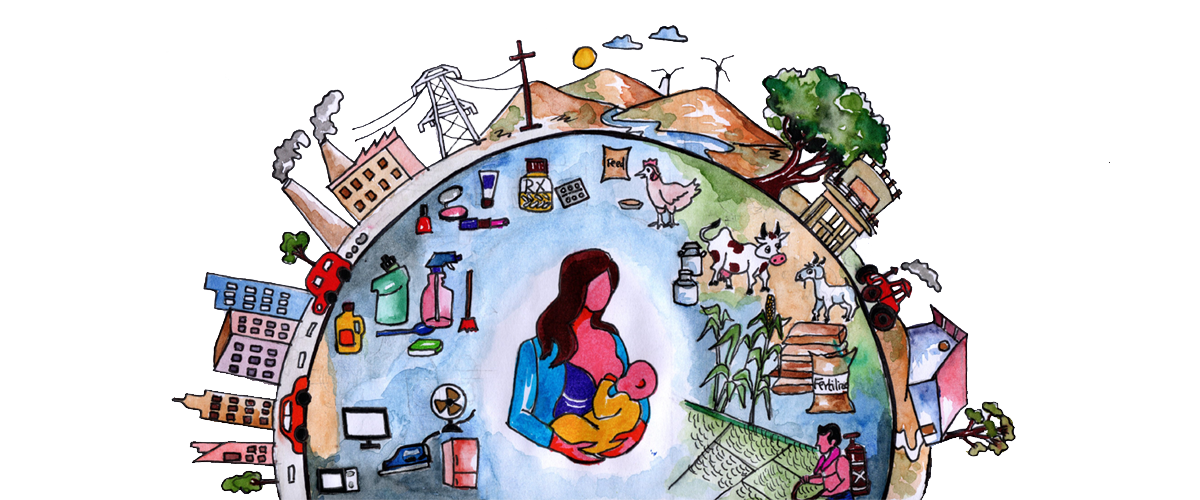
The environmental exposure of women is a concern, especially during pregnancy, and early motherhood. A woman or a mother is exposed to a myriad of environmental chemicals through food, personal care products, household products, medicines, pollutants, or through her occupational environment. During motherhood, the practice of breastfeeding is known to be important for the healthy growth and development of a child. Unfortunately, several environmental chemicals, which may affect the child, are capable of entering human milk. These are chemicals of concern, that need to be monitored carefully due to the potential impact they can have on the early development of a child. The measure of all the environmental exposures of an individual during their lifetime and their related health effects is called an exposome. We have created the Exposome of Human Milk across India (ExHuMId) as a repository of information on infant exposures to environmental chemicals experimentally detected in breast milk from the published studies carried out across India, with the aim of providing the inputs necessary for monitoring and regulating these environmental chemicals in the future.
Exposome of Human Milk across IndiaExHuMId is a knowledgebase of chemicals experimentally detected in human milk samples, collected from published studies carried out across India. The data in ExHuMId has been compiled through manual curation, from published scientific literature. Through literature search in PubMed, we first compiled 1704 research articles on human milk, published until 24 August 2020. These 1704 articles were filtered based on their study type, test organism, and geographical location from which the samples were collected. ExHuMId version 1.0 released on 06 November 2020, contains detailed information on 101 environmental contaminants that were experimentally detected in human milk samples across India, compiled from 36 published research articles (which were manually curated from 1704 research articles).
ExHuMId compiles a comprehensive range of information on human milk contaminants, from studies across 13 states of India. Identifiers and structural information, such as IUPAC names, PubChem, CAS, canonical SMILES, InChI and InChIKey, have been compiled for each chemical. The two-dimensional (2D) and three-dimensional (3D) chemical structures for each chemical are available in SDF, MOL, MOL2 formats. Users can also find experimental data such as the detected concentration, units, sample size, testing methods, age of the mother and duration of the exposure (if any), and factors associated with mother who provided the sample. ExHuMId also compiles the geographical location from which the study samples were collected. All this data has been manually curated, unified, and standardized. In addition, users can access the physicochemical properties, predicted ADME properties, predicted toxicity profiles and molecular descriptors of each chemical. The chemicals in ExHuMId are categorized based on their chemical class, environmental source, the geographical location from where the sample was collected, and the factors associated with the individual who provided the sample. The environmental source follows 6 broad categories and 35 sub-categories. Chemical structure classification follows the ClassyFire hierarchy of Kingdom, Superclass, Class and Subclass which spans 2 kingdoms, 8 chemical superclasses and 21 classes. The 101 chemicals in this knowledgebase are associated with one or more of 9 standardized factors associated with mother at the time of sample collection. The chemicals have been detected in studies conducted in geographical locations across 13 states of India. The comprehensive experimental data compiled in ExHuMId, including significant information regarding factors associated with mother and environmental sources of human milk contaminants, can assist biomonitoring efforts to a great extent. We believe it is necessary to make conscious decisions and take effective steps in ensuring that breastfeeding continues to become safer for the mother and child. We aim for ExHuMId to serve research efforts in understanding the effects of these chemicals on the body, and to be useful in the regulatory decision-making process regarding human milk contaminants.
CITATION
If you use our resource, please cite the following research article:B.S. Karthikeyan#, J. Ravichandran#,*, S. R. Aparna & A. Samal*, ExHuMId: A curated resource and analysis of Exposome of Human Milk across India, Chemosphere, 271:129583 (2021).
# Joint-First authors; * Corresponding authors.